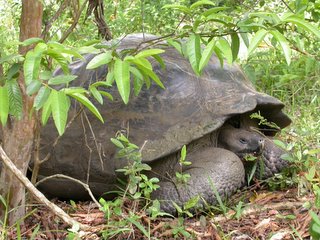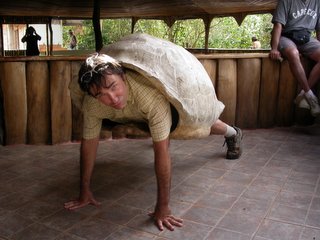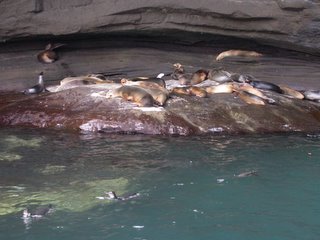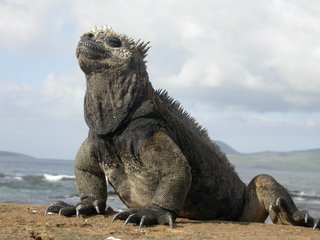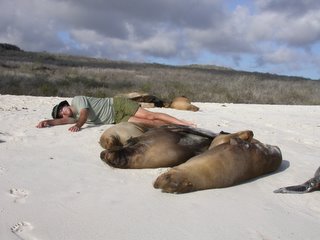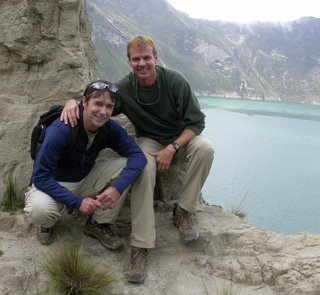
What a difference Mendoza, Argentina, is to Ecuador. While we arrived only yesterday, it is really striking how different it feels to be someone that blends in to the crowd, whereas in Ecuador we really stood out as tall, pale-skinned Gringos.
So far, Mendoza has been a a really disorienting mix of the familiar and unfamiliar. (The disorientation is aided by the fact that both Gary and I are still experiencing rocking motions from having sailed the Pacific for 7 days.) Mendoza´s blue sky, gentle sun, neighboring mountains, and urban-town composure feel a lot like home-sweet Boulder in late Summer, right down to a leafy pedestrian downtown mall. Meanwhile, the dated architecture feels very 1950´s, as does the people´s very European concern for their public appearence in stylish dress and public grooming. No chance of seeing an obsese waddler in sweat pants here.
A interesting paradox is that while we stood out in Ecuador, we did not get many appraising looks, since we were just another pair of gringos. Meanwhile, in Mendoza we are getting lots of appraising looks because here everyone is checking out everyone else.
 Upon arriving in Mendoza, tired after about 12 hours of travel, we did something we have not done in more than a decade -- eat McDonald´s. It is shocking how good the meat in the McBurgers around here is. Argentina is a big cattle country, and Argentines really like red meat, so we are guessing that McDonald's cannot sell burgers here unless they use decent meat. It´s odd that some American consumer products are better abroad than at home. In addition to the McDonald´s tasting better, Coke does too - because in Latin America Coke is still made with sugar, not high-fructose corn syrup.
Upon arriving in Mendoza, tired after about 12 hours of travel, we did something we have not done in more than a decade -- eat McDonald´s. It is shocking how good the meat in the McBurgers around here is. Argentina is a big cattle country, and Argentines really like red meat, so we are guessing that McDonald's cannot sell burgers here unless they use decent meat. It´s odd that some American consumer products are better abroad than at home. In addition to the McDonald´s tasting better, Coke does too - because in Latin America Coke is still made with sugar, not high-fructose corn syrup.
 On the left is a downtown shopping mall at 2 pm on a weekday afternoon. People here take their siestas really seriously. All the stores are shutdown from 1 pm to 4 pm.
On the left is a downtown shopping mall at 2 pm on a weekday afternoon. People here take their siestas really seriously. All the stores are shutdown from 1 pm to 4 pm.
There seems to be a curiously large number of people in Mendoza limping, or walking around with the help of crutches or various types of braces. I have also seen quite a few shops that specialize in selling orthopedic supplies. I´m not sure what´s going on. The driver-safety standards do not seem to be any more insane here than anywhere else in Latin America. Most of the limpers (but not the folks with crutches or braces) were young men, which suggests that they may have been injured playing soccer. But again, young men play soccer all over Latin America, and this is the first place where I see so many limpers. Any ideas out there?
Finally, another odd, first impression is the extreme levels of public courtesy and rudeness. On the courtesy side, it is not unusual for strangers to open doors for us. In one case, a fellow passenger on an elevator insisted that I disembark before him, even though I was behind him in the elevator.
On the rudeness side, people can be comically aggressive about trying to cut in front of you in line. On the afternoon we arrived, I was waiting to buy a cup of fresh grape juice from a street stand. A girl of about 10 years of age came after me, used her elbow and shoulder to push me aside and get a more prominent spot at the counter, and started rapping her coin on the counter, hoping to get the sale person´s attention before I could.
In another case, Gary and I were at a market and while the cashier was making change on our purchase, a fellow came from behind us, slammed down the item he was buying, and started waving his money and asking the cashier to ring him up, in the apparent hope that the cashier would stop our transaction to service this fellow who just arrived at the counter. The cashier did not seem the least bit surprised at this behavior and simply ignored him.
Finally, at a barber shop, where I had been waiting for 15 minutes for a hair cut, an old guy came and successfully cowed the barber into taking him before me. I left.
Hey, for people tuning in who do not already know us, we also have other travel journals at our web site, rickandgary.com

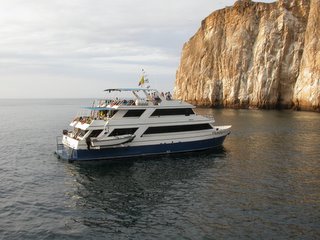 The room is rocking back and forth in Quito as I (Rick) sit at the computer at the Intenet Cafe. This is the after effect of being on this boat in the Pacific for 7 days. Neither of us had sea sickness, but boy there was a lot of rocking and my equilibrium has yet to recover.
The room is rocking back and forth in Quito as I (Rick) sit at the computer at the Intenet Cafe. This is the after effect of being on this boat in the Pacific for 7 days. Neither of us had sea sickness, but boy there was a lot of rocking and my equilibrium has yet to recover.